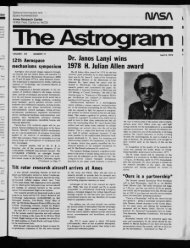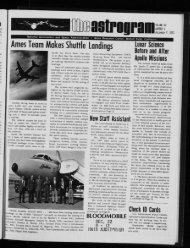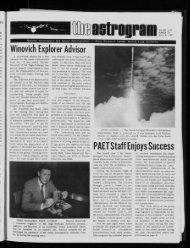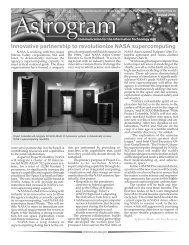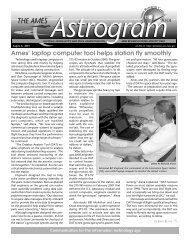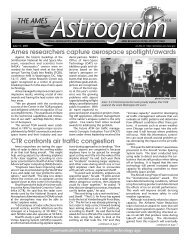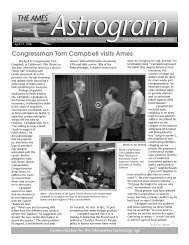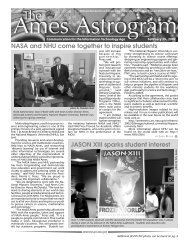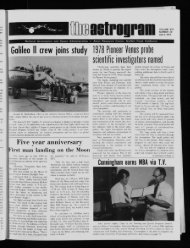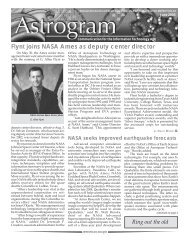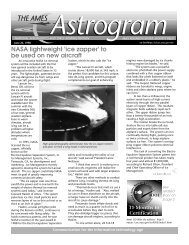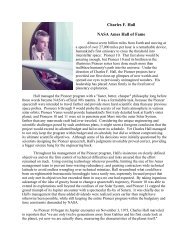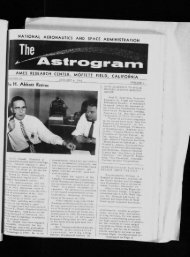1976 July-September - NASA Ames History Office
1976 July-September - NASA Ames History Office
1976 July-September - NASA Ames History Office
Create successful ePaper yourself
Turn your PDF publications into a flip-book with our unique Google optimized e-Paper software.
Nattonal Aeronautics and<br />
Space Adminislration<br />
<strong>Ames</strong> Research Center<br />
Moffe~t Field. California 94035<br />
VOLUME XVlll NUMBER 23<br />
Successful landing on Mars for Viking 1<br />
Upper left<br />
<strong>July</strong> 29, <strong>1976</strong><br />
Viking I Landed in one of the kywest regions on<br />
the surface of Mars. Center oJ the Landing ellipse<br />
inscribed on this photomosaic of j?ames is located at<br />
22.4° A~ Lat.. 4Z5° W. Lo~lg., bl ChrysePLa~itta. The<br />
new location is about 740 kilometers (460 mffes)<br />
northwest of the original <strong>July</strong> 4 landing sue and<br />
240 kilometers (150 miles) west alan alternate site<br />
where the spacecraft was to touch down on <strong>July</strong> 1 Z<br />
This area ts neart~ three kilometers (two miles)<br />
below Mars’ mean "sea level "’ It is a channelled towland<br />
northeast of the great Martian volcanoes and<br />
the TharsL~ PLateau. the high altitude equatorial<br />
region<br />
Lower left<br />
l-irst panoramic fiew b3 Viking I from the sur-<br />
]ace of Mars. (Top) The out-of-focus spacecraft<br />
c~mlr~nent to~,ard left center ts the housing for the<br />
~Tking sample arm. whieh i~ not vet deptos ed. Parallel<br />
line~g in the sky are an artifact and are not real<br />
t~atures Howe~er, the change of breghtness from<br />
horizon towards zenith and towards the rtgh:t (west)<br />
is accuratet) r(fle~ted in tht~" picture, taken in late<br />
Martian a tternoon. At the horizon to the left ~ a<br />
plateau-like prominence much brighter than the<br />
]breground material between the rocks. The horizon<br />
features are approxirnateO" three kilometers<br />
(1 8miles) awal’ At l(ft is a collection of finegrained<br />
material reminiscent of sand dune~. The<br />
dark sinuous markings in left toreground are of<br />
unkm;wn origin Some umdentffied shapes can be<br />
percened on the hill.v eminence at the horizon<br />
toward.~ tile right Parches of bright sand can be<br />
dt;cented amoprg the rocks and boxdders in middle<br />
distatlcc [, right fbreground are tw~ pecullarl)’<br />
ghaped roeks a,hic’h ma~ possibl~ be venrtfacts produeed<br />
b~ wmdabn~ston on Mars A horizontal ckyud<br />
stratum can be made out ha[t]~,al tkt)m the horizon<br />
to the top of the picture (Bottom) At let? is seen<br />
the low gain antenna for receipt t~f eomtr~dnds.frt~m<br />
lhe ~.~rlh Tf~e proiections on or near the flatiron<br />
tnav rt~pr~,sent the rims dL~tant impact craters. ]n<br />
right fi)regroz&tld are color charts t~kr Lander catnera<br />
calibration, a m~rror for the I’ikulg mag~etic propew<br />
tws experiment and part of a grid t~tl the top ~.tthe<br />
Lander bad1. At upper r~ght ts the high-gain dish<br />
antentta .for dzrect contmttnication between Landed<br />
spaeecra]~ and Earth. Toward the right edge i~ an<br />
array of smooth fine-grained material ~hich shows<br />
some hint of ripple structure and may be the beginning<br />
of a klrge dune (hqd off m the right of the<br />
picture, which /alas with dunes seea at the top left<br />
in this dO0~ panoramic view. Some of the racks<br />
appear to be undercut on otle sid~ and partiall~<br />
buried hi" drifting sand on the o ther



